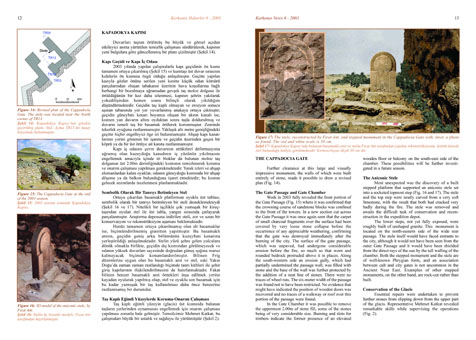
THE CAPPADOCIA GATE
Further
clearance at this large and visually impressive monument, the
walls of which were built entirely of stone, made it possible
to draw a revised plan (Fig. 14)
The Gate Passage and Gate Chamber
Work in 2003 fully revealed the front portion of the Gate Passage
(Fig. 15) where it was confirmed
that the crowning course of sandstone blocks was confined to
the front of the towers. In a new section cut across the Gate
Passage it was once again seen that the carpet
of small charcoal fragments over the surface had been covered
by very loose stone collapse before the occurrence of any appreciable
weathering, confirming that the gate was destroyed immediately
after the burning of the city. The surface of the gate passage,
which was unpaved, had undergone considerable erosion before
the fire, so much so that worn and rounded bedrock protruded
above it in places. Along the south-western side an erosion
gully, which had partially undermined the passage wall, was
filled with stone and the base of the wall was further protected
by the addition of a neat line of stones. There were no traces
of wheel ruts. The six-meter width of the passage was found
not to have been restricted. No evidence that might have indicated
the position of wooden doors was recovered and no traces of
a walkway or roof over this portion of the passage were found.
In the Gate Chamber it was possible to remove the uppermost
2.00m of stone fill, some of the stones being of very considerable
size. Burning and slots for timbers indicate the former presence
of an elevatedwooden floor or balcony on the south-east side
of the chamber. These possibilities will be further investigated
in a future season.
The Aniconic Stele
Most unexpected was the discovery of a built stepped
platform that supported an aniconic stele set into a socketed
topmost step (Fig. 16 and
17). The stele
and the top step were neatly carved from a very soft limestone,
with the result that both had cracked very badly during the
fire. The stele was removed and awaits the difficult task of
conservation and reconstruction in the expedition depot.
The lower steps, not yet fully exposed, were roughly built of
unshaped granite. This monument is located on the north-eastern
side of the wide rear passage. The stele itself would have faced
entrants to the city, although it would not have been seen from
the outer Gate Passage and it would have been shielded from
the direct rays of the sun by the tall walling of the chamber.
Both the stepped monument and the stele are of well-known Phrygian
form, and an association
between cult and city gates is not uncommon in the Ancient Near
East. Examples of other stepped monuments, on the other hand,
are rock-cut rather than built.
Conservation of the Glacis
Essential repairs were undertaken to prevent further
stones from slipping down from the upper part of the glacis.
Representative Mehmet Katkat revealed remarkable skills while
supervising the operations (Fig. 2).
|
|
|



